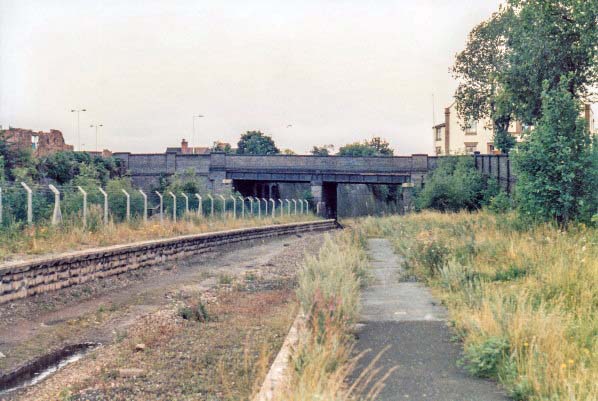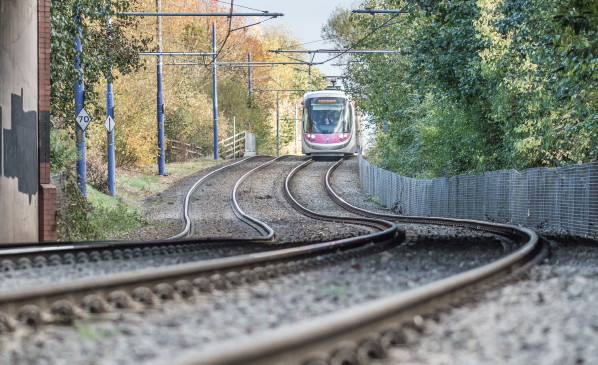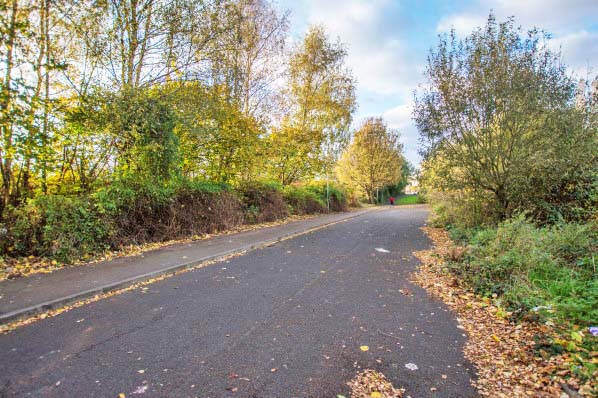|
Notes: The construction of a railway north from Birmingham Snow Hill to Wolverhampton, through to Priestfield, where it would meet the Oxford, Worcester & Wolverhampton Railway (OWWR) was authorised on 3 August 1846 to the Birmingham, Wolverhampton & Dudley Railway (BWDR). The BWDR favoured leasing the line to the Great Western Railway (GWR) from the outset as it planned the line to be constructed to the GWR’s broad gauge (7ft 0¼in) rather than what was, increasingly, the standard gauge (4ft 8½in). Negotiations with the GWR in regard to leasing and running the line started on 12 November 1846, only months after the railway company had been incorporated, and by Act of Parliament of 31 August 1848 the BWDR was purchased by the GWR prior to any construction taking place. Construction of the line was started by the GWR during 1851 and by June 1852 the original Act was due to lapse and the GWR successfully applied to Parliament for a 3½-year extension to the original Act. The GWR had attempted not to construct the line at all preferring to negotiate with the London & North Western Railway (LNWR) to gain running rights along the Stour Valley line; negotiations failed as the, ever suspicious, LNWR was attempting to delay the GWR reaching its ultimate goal, Liverpool.
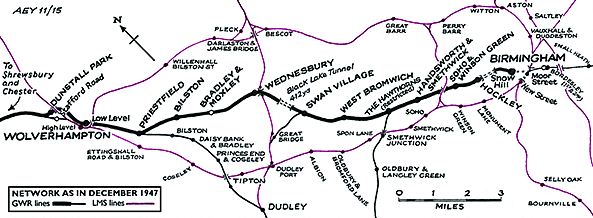
Construction of the Snow Hill to Priestfield section of the BWDR was complete by the summer of 1854 and the line was duly inspected by Captain Sir Douglas Strutt-Galton in August. It is not recorded whether the inspection was a success, but the following day a tubular bridge over the turnpike road at Winson Green collapsed after the passage of a contractor’s locomotive working a ballast train. Isambard Kingdom Brunel visited the line the following day and a thorough inspection of the bridges along the route with John Mc Clean, the resident engineer, resulted in five of them being condemned. The opening of the line had been set for 1 September 1854 but this was now unachievable as remedial work on the structures was to take some months. Following the strengthening of the five bridges the line was again inspected and passed fit for traffic, opening on 14 November 1854.
The station at Bilston opened on 14 November 1854, the day the line officially opened, and was a rather grand affair comprising of two through platforms, a large goods shed and two independent lines which ran to the rear of the down (Wolverhampton direction) platform. Located south-east of Hall Street, the main station driveway could be reached either from Hall Street, Brook Street or Railway Street.
The main building and accommodation were located on the Birmingham-bound (up) platform. Its design, seen also at Handsworth & Smethwick, Wednesbury Central and West Bromwich stations, was in an austere Classical style, imposing and highly distinctive. The style is not unlike some of those by the noted railway architect Francis Thompson, such as Holywell Junction, but it seems unlikely that he had any direct influence on Bilston and its neighbours. A two-storey central block rose above single-storey wings, reminiscent of a child’s drawing of a ship. The particular, somewhat dour, character of the building was given by the parapet (or blocking course) on the front and rear single-storey elevations and a cornice on the central section, almost concealing hipped roofs that lay behind them – a style associated with terraces with Classical pretensions in London, Bristol and Cheltenham. Although the overall construction was of brick, stone pilasters contributed gravitas to the upper .jpg) storey of the central block, and stone was also employed in the cornices, parapets, quoins and the string course that surrounded the building. The openings on the upper floor and on the forecourt elevation of the wings were rectangular, with tablets below them bearing a simple geometric pattern; the central section of this elevation and all ground floor openings on the platform side were broad segmental arches apart from one centrally placed rectangular window. The arched openings were given stone quoins in a radial layout which added the only cheerful note to the otherwise sombre design. At the north-west end of the building was a short, single-storey extension with a lower roof-line than the adjoining wing repeating its style, even to the inclusion of a parapet. An awning stretched along the platform elevation of the building; it is thought to have been a ridged structure carried on ornamental brackets but at some stage a rather crude-looking replacement with a deep, flat valance replaced it, using the original pillars for support. It must not be forgotten that photographs of the building in its later years record a structure encrusted with soot from the numerous factories and houses in the locality which undoubtedly contributed to its sombre appearance. storey of the central block, and stone was also employed in the cornices, parapets, quoins and the string course that surrounded the building. The openings on the upper floor and on the forecourt elevation of the wings were rectangular, with tablets below them bearing a simple geometric pattern; the central section of this elevation and all ground floor openings on the platform side were broad segmental arches apart from one centrally placed rectangular window. The arched openings were given stone quoins in a radial layout which added the only cheerful note to the otherwise sombre design. At the north-west end of the building was a short, single-storey extension with a lower roof-line than the adjoining wing repeating its style, even to the inclusion of a parapet. An awning stretched along the platform elevation of the building; it is thought to have been a ridged structure carried on ornamental brackets but at some stage a rather crude-looking replacement with a deep, flat valance replaced it, using the original pillars for support. It must not be forgotten that photographs of the building in its later years record a structure encrusted with soot from the numerous factories and houses in the locality which undoubtedly contributed to its sombre appearance.
The up platform was linked to the down by a lattice-work footbridge and this platform had far humbler buildings, consisting of an awning of comparable length to its opposite number, but with small shelters at either end and a screen wall stretching between them. In later years this awning was removed and in its place a small waiting shelter was provided for passengers travelling to Wolverhampton.
The station’s location was convenient as it stood close to the centre of the small, but expanding, Black Country town. Confusion reigned for almost a century, however, as the GWR had opened another station named Bilston a few months earlier, on the OWWR line from Priestfield to Dudley and less than ½-mile as the crow flies from the station which is the subject of this article. Bradshaw’s index unhelpfully listed both stations simply as ‘Bilston’ and, of necessity informal suffixes emerged to distinguish the two: ‘Bilston Broad Gauge’, ‘Bilston Main’ and ‘Bilston & Ettingshall’ were used at one time or another for the Snow Hill – Wolverhampton Low Level station. In the nineteenth century the North Eastern Railway had compulsively renamed many of stations to avoid any such confusion, but the GWR seemed quite unconcerned by its two Bilston stations. British Railways (Western Region) must have swiftly grown exasperated by the totally unnecessary confusion, and on 2 June 1950 the nettle was firmly grasped and the problem finally resolved when the Snow Hill - Wolverhampton station was formally named ‘Bilston Central’ and the other ‘Bilston West’. Bilston Central eventually reverted to Bilston when the ‘West’ station closed.
Bradshaw’s December 1895 shows the station having a frequent service from 6.29 am through to 12.02am in the Wolverhampton direction (down) totalling 19 working on weekdays with eight on Sunday. In the up direction (Birmingham) 7.02am would take the traveller through to Snow Hill, with 11.24pm being the final departure of the day (also to Snow Hill) totalling 18 weekday workings. Nine up services are recorded on Sunday. Again, as with most rail services, the First World War caused a reduction in their frequency, but by July 1922 an improvement can be seen with Bradshaw’s showing 24 down workings from 6.06am through to 11.42pm, weekdays, and nine Sunday services. In the up direction there were 23 services from 5.44am through to 10.47pm, weekdays, with 10 on Sunday.
 |
To see a large version click here
At the time of the ‘Big Four’ Grouping of 1 January 1923 Bilston remained under the control of the GWR. It is thought that the electric lighting which survived at the station until the 1970s was installed during the Grouping era, using concrete lamp standards of a design normally associated with the Southern Railway. On 1 January 1948 the railways were nationalised and Bilston came under British Railways (BR) Western Region (WR) administration.
Following the cessation of the Second World War service levels began to rise to their pre-war levels. The BR(WR) timetable of May 1949 shows Bilston to have a slightly improved service with 27 down (Wolverhampton direction) services on Monday-to-Friday, 26 on Saturday and 12 on Sunday. In the opposite direction (up) on Monday-to-Thursday there were 22 services, 23 on Friday and 24 on Saturday with 11 Sunday services. The railways at this juncture were tapping into the holiday market for the war-weary public with many special trains operating during the peak season or, in fact, for the whole period of the timetable. Bilston, as a principal station along the route, was no exception with analysis of the 1949 timetable showing a Saturday-only working to and from Torquay (2 July to 10 September) departing 9.18am with the return working arriving at 4.16pm. Penzance too could be reached directly on the Saturday-only 9.06am and Sunday 10.17am departures with the return workings arriving back at Bilston at 7.40pm on Saturday and 9.32pm on Sunday. The 9.48pm and 10.48pm departures, both Friday-only, are worthy of note as both conveyed through carriages to Newquay, Penzance, Torquay and Paignton. By the early 1950s, with car ownership increasing, these services started to disappear and the WR began to concentrate on operating more local services interlaced with the Paddington and Birkenhead expresses.
Some limited modernisation was carried out at Bilston Central in the late 1950s with the installation of BR(WR) totem nameplates and exceptionally large running-in nameboards, so long, indeed, that a central stanchion was required to prevent them from sagging; existing GWR nameboard stanchions might have dictated the size of the BR boards.
During the London Midland Region’s (LMR) electrification programme of the West Coast main line (WCML), started in 1958, the ex-GWR route saw an increase in passenger services as many extra trains were run via the WR metals to compensate for the reduction in services on the WCML. Although this did not affect the service at Bilston Central it seemed to cement the former GWR route as still being a primary main line. Plans revealed by the BR(WR) in the early 1960s for the rebuilding of Snow Hill and the introduction of new diesel Pullman services all pointed towards the future being bright. Building work at the station, in the early 1960s, consisted of modernisation of the passenger facilities on the down (Wolverhampton) platform. The buildings and awning were demolished and replaced with a diminutive waiting shelter; this destruction was, in fact, a positive move underlining the WR’s commitment to the route. On 1 January 1963 boundaries of BR regions were redrawn and Bilston Central station came under the control of BR(LMR), and with the completion of the electrification programme and the linking of the main line from Paddington to Birmingham New Street the route north of Snow Hill was considered to be secondary. From the 14 June 1965 the LMR removed the ‘Central’ suffix from Bilston – because the other Bilston had recently closed - but signage was not replaced; instead, ‘Central’ was crudely painted out on the WR Totems, running-in-boards and the main station building sign. The penny-pinching ‘make-do-and-mend’ alteration was also carried out at several other former WR stations (e.g. Soho & Winson Green) which had recently been transferred to LMR administration and lost part of their name. This contradicted the official British Rail ‘Corporate Identity’ policy unveiled in early 1965 in which modern black and white signage would be fitted at stations to replace the former regional colours as part of the organisation’s attempt to project a progressive image.
The, now infamous, report published in 1963 by Dr Richard Beeching, The Reshaping of British Railways, made no mention of the line from Snow Hill to Wolverhampton although the LMR certainly wished to prune the route from its network. In 1966 BR(LMR) issued a proposal to close the Birmingham Snow Hill to Wolverhampton Low Level route, and all stations, in its entirety. In 1966 there were 24 trains in each direction to and from Wolverhampton, with around 2,000 people per day travelling on these services (the figure included the Snow Hill to Langley Green shuttle). Objections were posted to the Transport Users’ Consultative Committee (TUCC) and the case for .jpg) closure was discussed on 20 September 1966. The recommendation of the TUCC was the that line should remain open as closure would cause ‘extreme hardship’. This ruling caused the LMR to change tactics with the announcement that as of 4 March 1967 the main line trains along the whole route would be withdrawn and freight trains diverted along other routes. On 15 November 1967 the Minister of Transport, Barbara Castle responded to BR’s closure application refusing to allow the closure of the Wolverhampton to Snow Hill and the branch to Langley Green, but allowing the closure of the southern section from Snow Hill towards Stratford and Leamington. With the line virtually truncated at both ends the LMR reduced the service level, and with the introduction of the May 1968 timetable Bilston saw 24 down (Wolverhampton direction) services on Monday-to-Friday and 23 on Saturday; the up workings consisted of 24 departures on all weekdays and the Sunday service was withdrawn. The May 1969 timetable saw the service reduced even further as the LMR attempted undermine the line’s viability by running as few trains as possible; the station at Bilston became unstaffed at the same time. The station infrastructure started to deteriorate as no repairs were completed and vandalism started to become a real problem owing to the absence of station staff. The buildings survived into the 1970s, unlike some others along the line. closure was discussed on 20 September 1966. The recommendation of the TUCC was the that line should remain open as closure would cause ‘extreme hardship’. This ruling caused the LMR to change tactics with the announcement that as of 4 March 1967 the main line trains along the whole route would be withdrawn and freight trains diverted along other routes. On 15 November 1967 the Minister of Transport, Barbara Castle responded to BR’s closure application refusing to allow the closure of the Wolverhampton to Snow Hill and the branch to Langley Green, but allowing the closure of the southern section from Snow Hill towards Stratford and Leamington. With the line virtually truncated at both ends the LMR reduced the service level, and with the introduction of the May 1968 timetable Bilston saw 24 down (Wolverhampton direction) services on Monday-to-Friday and 23 on Saturday; the up workings consisted of 24 departures on all weekdays and the Sunday service was withdrawn. The May 1969 timetable saw the service reduced even further as the LMR attempted undermine the line’s viability by running as few trains as possible; the station at Bilston became unstaffed at the same time. The station infrastructure started to deteriorate as no repairs were completed and vandalism started to become a real problem owing to the absence of station staff. The buildings survived into the 1970s, unlike some others along the line.
Writing in Railway Magazine (June 1971) on ‘End of a Great Western Main Line?’ Geoffrey F Bannister drew attention to the sad fact that in the late 1960s many residents of Wolverhampton would have been unaware that the alternative [ex-GWR] service to Birmingham still existed, and he lamented the state of the eight intermediate stations between Snow Hill and Wolverhampton Low Level which had ‘gradually assumed an air of neglect and dilapidation’. His description of the termini is worth quoting in full:
‘The depressing walk from High to Low Level stations in Wolverhampton, through a dingy subway, together with the chalkboard notice outside the parcels depot directing potential passengers “through the yard” were certainly not calculated to attract custom for the “pay trains”. At the other end of the line, the remnant of Snow Hill is approached through a side entrance in Livery Street. In fact there has been an air of fatal inevitability about the whole affair.’
Between May 1969 and March 1972 the service remained at a constant level of six trains each way on Monday-to-Friday with one extra working on Saturday, in the early afternoon, to cater for shoppers wishing to travel to Birmingham or Wolverhampton. Passenger numbers had dwindled to one tenth of their 1966 level, and on 31 March 1971 the LMR made its move and posted closure notices for Wolverhampton Low Level to Birmingham Snow Hill, including the Langley Green shuttle; objections had to be received by 19 May 1971. The Transport Users’ Consultative Committee received 199 objections in total and on 25 May, they, along with representatives from BR and WMPTE (the Executive body of the WMPTA) inspected the route and all the stations, travelling from Snow Hill by train to Wolverhampton; ironically they returned by bus! A Public Hearing was held at the Rainbow Suite in Birmingham on 14 July 1971 to listen to objections and decide the future of the line. The statement issued by the TUCC could not have been clearer: ‘The addition of displaced rail passengers at these times would aggravate an already critical situation and would result in hardship for all concerned’. Despite this warning, on 24 January 1972 the Minister granted permission for closure to be implemented with a date quickly set for 4 March. On the final day trains were expected to be heavily patronised, so, instead of being the usual single car DMU the trains were strengthened to 3-car units with BR issuing souvenir tickets. The final Wolverhampton-bound train called at Bilston at 6.13pm with the final Birmingham-bound service having departed at 5.54pm.
The speed of the closure caught the timetable compilers unawares as the BR(LMR) publication of 1 May 1972 showed a phantom service of the familiar six Monday-to-Friday trains (seven on Saturday) in each direction between Birmingham Snow Hill and Wolverhampton Low Level, albeit with a warning that ‘the Department of the Environment has under consideration the withdrawal of this service … in the event of this taking place during the currency of the Timetable appropriate notice will be given’.
 |
The grand building at Bilston had been demolished in February 1971 while the station was still open; demolition of the similar structure at neighbouring Wednesbury was underway by late March. Bannister, writing in mid 1971, stated that if the service between Snow Hill and Wolverhampton were to survive ‘it is proposed to erect bus-type shelters for the protection of would-be passengers’. Such a shelter was not provided in the last year for Bilston’s Birmingham-bound passengers who had to brave the elements on the bare platform. The footbridge and diminutive waiting shelter on the down platform survived until closure but were soon to be demolished. Even though 4 March 1972 saw the end of passenger workings, steel trains servicing the Wolverhampton Steel Terminal continued to run from Bescot via the South Staffordshire line and Princes End Junction. These services ended in January 1983 after they were diverted along the Stour Valley line enabling the track north of Bilston New Basin to Wolverhampton to be lifted.
The West Midlands Passenger Transport Authority (WMPTA) had long recognised the importance of the Wolverhampton to Birmingham Snow Hill route although it did not became responsible for rail services until 1972, and nothing could be done to stop the closure. On 31 October 1973 the Authority and its Executive body took steps to protect the trackbed from any future development so that some kind of public transport system could be reintroduced. The Authority’s first success was the rebuilding of Snow Hill in the late 1980s, and the introduction of heavy rail services north of the station to Stourbridge and Kidderminster in 1995. With the first Metro proposal having to be abandoned owing to adverse public opinion and construction difficulties, the route of the former relief lines from Snow Hill to Swan Village and onward using the trackbed of the former double track main line to Wolverhampton was chosen. The WMPTA announced this on 16 February 1988 and on 16 November 1989 an Act of Parliament was granted for its construction. It was not until 3 August 1995 that the contract for construction was let to Altram, a consortium of Ansaldo and John Laing, with construction commencing on 13 November. The final section of track was laid on 4 February 1998 with public services beginning on 31 May 1999. A new tram stop bearing the name ‘Bilston Central’ is located just north-west of the original station site.
Today no trace remains of the station or goods yard with the majority of the station site having had industrial units constructed upon it. Railway Drive, which led to the station entrance off Brook Street, is extant and is the only evidence that a station once existed. The current alignment of the Midlands Metro runs through what were the main station building and the up Birmingham platform.
Tickets from Michael Stewart and route map by Alan Young.
Sources:
- Bradshaw's Railway Guide December 1895 - Middleton Press
- Bradshaw's Railway Guide July 1922 - Guild Publishing
- British Railways (WR) May - September timetble 1949
- British Rail (LMR) 3 May 1971 - 30 April 1972 timetable
- Forgotten Railways: Volume 10, The West Midlands - Rex Christinsen - David & Charles Publishing 1985
- A Regional History of the Railways of Great Britain - Volume 7 The West Midlands - Rex Christiansen - David St John Thomas Publisher 1991
- A Century of Railways around Birmingham and the West Midlands Vol 1,2 & 3 - John Boynton - Mid England Books Publisher 1999
- From Main Line To Metro - John Boynton - Mid England Books 2001
-
|

 An Ex-GWr 2-6-2T rolls into the station during the late 1950's with a southbound stopping service. The new waiting shelter on the Wolverhampton bound platform can just be glimpsed to the left.
An Ex-GWr 2-6-2T rolls into the station during the late 1950's with a southbound stopping service. The new waiting shelter on the Wolverhampton bound platform can just be glimpsed to the left.
 The 1876 1:2500 OS map shows the station site in 'as-built' condition complete with Goods Shed.
The 1876 1:2500 OS map shows the station site in 'as-built' condition complete with Goods Shed. 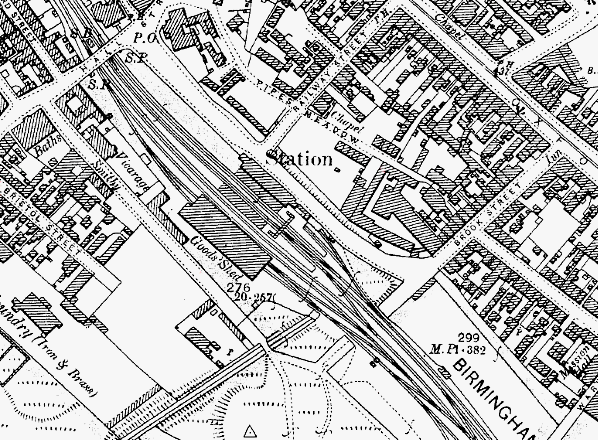 The 1903 1:2500 OS map gives a good indication of the sizeable building on the Wolverhampton platform.
The 1903 1:2500 OS map gives a good indication of the sizeable building on the Wolverhampton platform.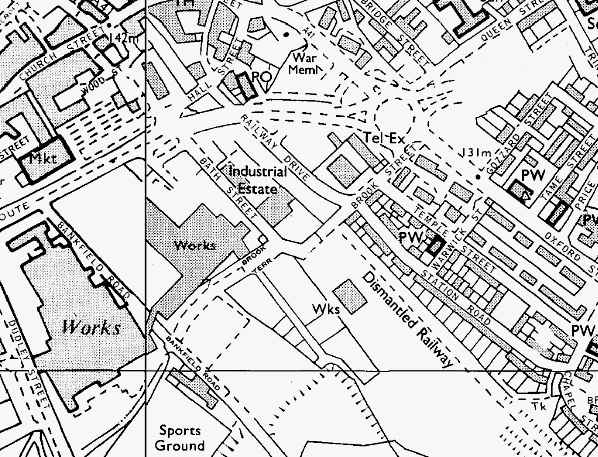 The 1:10000 map shows the station site following its demolition note how the Industrial Estate has encroached on the formation and the projected route of the new A444 Black Country Route.
The 1:10000 map shows the station site following its demolition note how the Industrial Estate has encroached on the formation and the projected route of the new A444 Black Country Route.
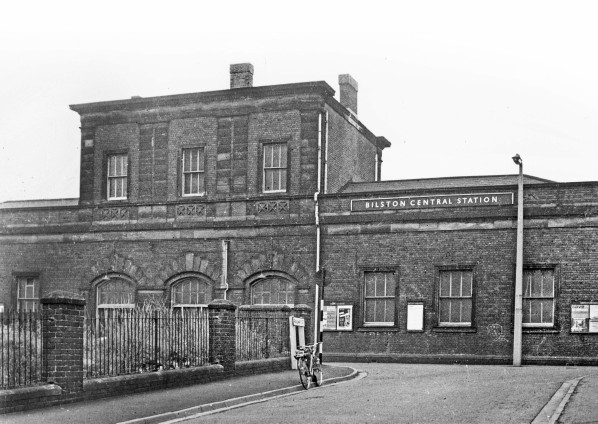 The main building seen from Railway Street still sporting its GWR signage.
The main building seen from Railway Street still sporting its GWR signage.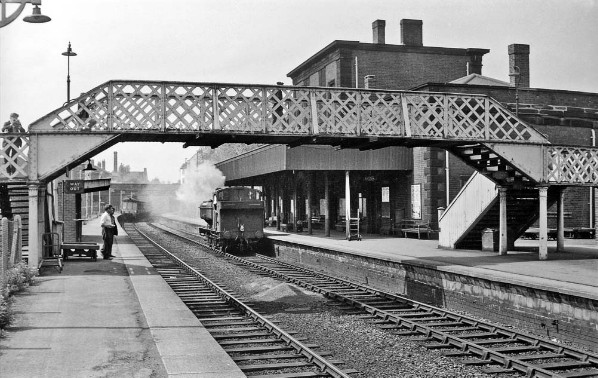 Looking in the Wolverhampton direction in June 1966 a DMU has just departed the station and an ex GWR Pannier Tank runs light engine through, in the Birmingham direction.
Looking in the Wolverhampton direction in June 1966 a DMU has just departed the station and an ex GWR Pannier Tank runs light engine through, in the Birmingham direction.
 Home Page
Home Page totem.gif)

.jpg) storey of the central block, and stone was also employed in the cornices, parapets, quoins and the string course that surrounded the building. The openings on the upper floor and on the forecourt elevation of the wings were rectangular, with tablets below them bearing a simple geometric pattern; the central section of this elevation and all ground floor openings on the platform side were broad segmental arches apart from one centrally placed rectangular window. The arched openings were given stone quoins in a radial layout which added the only cheerful note to the otherwise sombre design. At the north-west end of the building was a short, single-storey extension with a lower roof-line than the adjoining wing repeating its style, even to the inclusion of a parapet. An awning stretched along the platform elevation of the building; it is thought to have been a ridged structure carried on ornamental brackets but at some stage a rather crude-looking replacement with a deep, flat valance replaced it, using the original pillars for support. It must not be forgotten that photographs of the building in its later years record a structure encrusted with soot from the numerous factories and houses in the locality which undoubtedly contributed to its sombre appearance.
storey of the central block, and stone was also employed in the cornices, parapets, quoins and the string course that surrounded the building. The openings on the upper floor and on the forecourt elevation of the wings were rectangular, with tablets below them bearing a simple geometric pattern; the central section of this elevation and all ground floor openings on the platform side were broad segmental arches apart from one centrally placed rectangular window. The arched openings were given stone quoins in a radial layout which added the only cheerful note to the otherwise sombre design. At the north-west end of the building was a short, single-storey extension with a lower roof-line than the adjoining wing repeating its style, even to the inclusion of a parapet. An awning stretched along the platform elevation of the building; it is thought to have been a ridged structure carried on ornamental brackets but at some stage a rather crude-looking replacement with a deep, flat valance replaced it, using the original pillars for support. It must not be forgotten that photographs of the building in its later years record a structure encrusted with soot from the numerous factories and houses in the locality which undoubtedly contributed to its sombre appearance. 
.jpg) closure was discussed on 20 September 1966. The recommendation of the TUCC was the that line should remain open as closure would cause ‘extreme hardship’. This ruling caused the LMR to change tactics with the announcement that as of 4 March 1967 the main line trains along the whole route would be withdrawn and freight trains diverted along other routes. On 15 November 1967 the Minister of Transport, Barbara Castle responded to BR’s closure application refusing to allow the closure of the Wolverhampton to Snow Hill and the branch to Langley Green, but allowing the closure of the southern section from Snow Hill towards Stratford and Leamington. With the line virtually truncated at both ends the LMR reduced the service level, and with the introduction of the May 1968 timetable Bilston saw 24 down (Wolverhampton direction) services on Monday-to-Friday and 23 on Saturday; the up workings consisted of 24 departures on all weekdays and the Sunday service was withdrawn. The May 1969 timetable saw the service reduced even further as the LMR attempted undermine the line’s viability by running as few trains as possible; the station at Bilston became unstaffed at the same time. The station infrastructure started to deteriorate as no repairs were completed and vandalism started to become a real problem owing to the absence of station staff. The buildings survived into the 1970s, unlike some others along the line.
closure was discussed on 20 September 1966. The recommendation of the TUCC was the that line should remain open as closure would cause ‘extreme hardship’. This ruling caused the LMR to change tactics with the announcement that as of 4 March 1967 the main line trains along the whole route would be withdrawn and freight trains diverted along other routes. On 15 November 1967 the Minister of Transport, Barbara Castle responded to BR’s closure application refusing to allow the closure of the Wolverhampton to Snow Hill and the branch to Langley Green, but allowing the closure of the southern section from Snow Hill towards Stratford and Leamington. With the line virtually truncated at both ends the LMR reduced the service level, and with the introduction of the May 1968 timetable Bilston saw 24 down (Wolverhampton direction) services on Monday-to-Friday and 23 on Saturday; the up workings consisted of 24 departures on all weekdays and the Sunday service was withdrawn. The May 1969 timetable saw the service reduced even further as the LMR attempted undermine the line’s viability by running as few trains as possible; the station at Bilston became unstaffed at the same time. The station infrastructure started to deteriorate as no repairs were completed and vandalism started to become a real problem owing to the absence of station staff. The buildings survived into the 1970s, unlike some others along the line.
